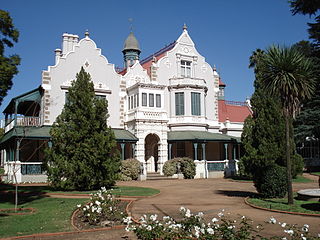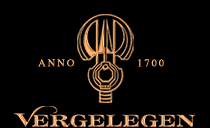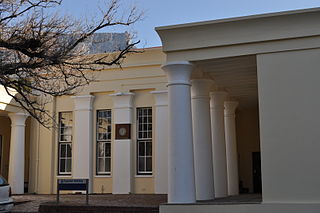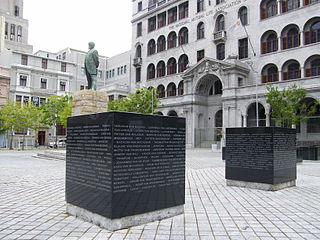
Melrose House is a stately mansion and museum located opposite Burgers Park in Pretoria, South Africa.

Sir Herbert Baker was an English architect remembered as the dominant force in South African architecture for two decades, and a major designer of some of New Delhi's most notable government structures. He was born and died at Owletts in Cobham, Kent.

Vergelegen is a historic wine estate in Somerset West, in the Western Cape province of South Africa.

The "!Oroǀõas" ("Ward-girl"), spelled in Dutch as Krotoa or Kroket, otherwise known by her Christian name Eva, was a !Uriǁ'aeǀona translator who worked for the Vereenigde Oostindische Compagnie (VOC) during the founding of the Cape Colony.

Leeuwenhof is an estate in the Gardens area of Cape Town, South Africa. It is the official residence of the Premier of the Western Cape. Leeuwenhof was originally a farmhouse dating to the time of the Dutch East India Company's rule of Cape Town. It includes a Slave Quarters which has been renovated and used to house an exhibition about slavery in Cape Town. It was declared a national heritage site on 15 December 1966.

The Suid-Afrikaanse Akademie vir Wetenskap en Kuns (SAAWK) is a multidisciplinary organization dedicated to promoting science, technology and the arts in Afrikaans, as well as promoting the use and quality of Afrikaans. The Hertzog Prize is awarded annually by the academy for high-quality literary work, while the Havenga prize is awarded annually for original research in the sciences.

Jamestown, also known as Webersvallei plus Mountain View, is a quiet rural settlement on the southern outskirts of Stellenbosch in the Cape Winelands District of the Western Cape province of South Africa. It is situated next to Blaauwklippen Vineyards, on the eastern side of route R44 from Stellenbosch to Somerset West and the Strand coastal resort. The main access from the R44 is via Webersvallei Road, the main road in Jamestown with watererven – long, narrow agricultural plots on the south bank of Blouklip River – on the north side of the road and residential plots on the south side of the road.

Johannes Albertus Munnik Hertzog was a South African politician, Afrikaner nationalist, cabinet minister, and founding leader of the Herstigte Nasionale Party. He was the son of J. B. M. (Barry) Hertzog, a former Prime Minister of the Union of South Africa.

The Houses of Parliament is the meeting place of the Parliament of South Africa, the legislative body of the Government of South Africa. The building is located in South Africa's legislative capital, Cape Town.

The South African Sendinggestig Museum was established in 1977 and is currently situated in the centre of Cape Town, Western Cape, South Africa. It is a province-aided museum which receives support from the Government of the Western Cape Province.

The Treaty Tree is a 500-year-old white milkwood tree on Treaty Road and south of the rail line in Woodstock, Cape Town, South Africa. Peace was made under the tree on 10 January 1806 after the Battle of Blaauwberg, thereby starting the second British occupation of the Cape and leading to the permanent establishment of the Cape Colony as a British possession. Until 1834 slaves were sold and convicts hanged under it.
Josephus Jacobus de Jager known as Jip de Jager, was a South African politician. He served as the mayor of Bellville, Western Cape, South Africa from 1973 to 1975 and again from 1978 to 1979. Outside of politics, de Jager was a German teacher in town and an advocate for bilingual education.

Coornhoop is a historic 17th century farmhouse. It is located at 2 Dixton Road in Observatory, Cape Town. Currently, it houses the Centre for Conflict Resolution.
The Reformed Church Windhoek is the oldest of the three Dutch Reformed churches in Windhoek, the capital of Namibia.
The Reformed Church Windhoek-South is the second-oldest of the three Reformed Churches in South Africa (GK) congregations in Windhoek, the capital of Namibia, and the largest of that denomination in the entire country by number of professed members.

The Martin Melck House on 96 Strand Street and the Kostershuis on 100 Strand Street, on either side of the Lutheran Church in Cape Town, are both national heritage sites of South Africa.
Boshofpoort is one of the best-preserved Cape farm entrances from the 18th century. It is located in Newlands where Boshof Avenue meets Paradise Road. It has an elevation of 1321 metres.

The Egyptian Building is the home of University of Cape Town's Michaelis School of Fine Art on that school's campus on Orange Street in Cape Town, South Africa.

Church Square in Cape Town, South Africa, lies in front of the Groote Kerk at the intersection of Parliament and Spin Streets. It currently features a park.

Martha Mabel Jansen, DMS was a South African educator, writer, journalist, cultural leader, politician and pioneer in the promotion of Afrikaans, as well as the spouse of the penultimate Governor-General of the Union of South Africa, E.G. Jansen.















